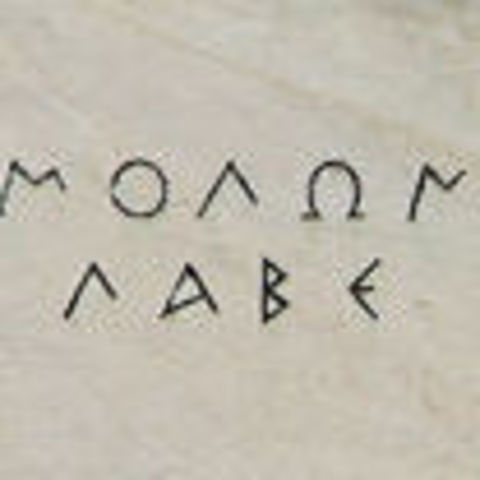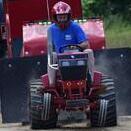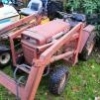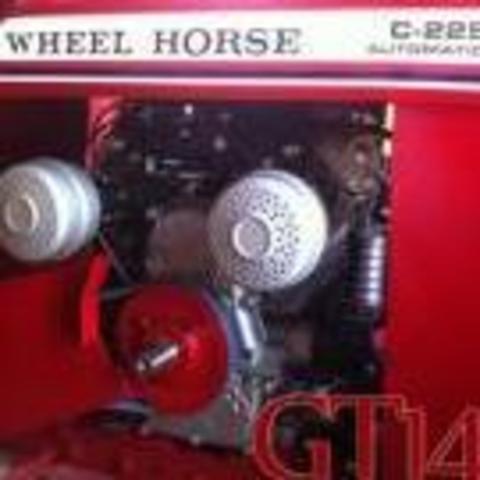Search the Community
Showing results for tags 'gt 14'.
Found 17 results
-
I have a Kohler K341 on a GT 14 tractor. Its always had the typical .....what are they called?........pepper shaker muffler? on the tractor. I've had to replace them several times....they seem to just eventually burn up. I can honestly say even from day one whenever I installed a new muffler of this type, I really couldn't tell that it really muffled much noise, maybe a little, but very little. As usage time goes on, they all got nothing but louder. Of course, part of this is the sheer displacement of the motor......35.9 cu. in. = 588 cc. Think of it in terms of a slightly bored out Norton Manx 500 cc thumper with an open megaphone exhaust. Deafening! You don't want to be standing 8 or 10' behind a Manx when it being warmed up and the throttle is being "blipped" to do that, without ear protection. These older flat head engines seem to be much louder than the newer OHV engines which are common in lots of equipment now. I've owned and used this tractor for 35 years now, and I guess I'm beginning to become somewhat of a crotchety old senior, but its becoming annoying to me (the operator), and I in fact had one neighbor that ragged me out over the noise. It may be because they have a pool and spend a fair amount of time outside, and the pool is about 10-11 feet from a chain link fence that divides the properties. I'm really not that worried about the neighbor nearly as much as I am myself, or should I say my hearing. I already have hearing loss from years of firing pneumatic nail guns and listening to compressors and heavy machinery running on job sites. What are you other K341 owners using and doing to get more muffling accomplished? Surely there has to be a more reasonable solution which will allow you to hear yourself think after an hour or hour and a half of operation. Is there a viable, positive solution for this problem so my ears and head don't ring for an hour after just mowing my lawn? Regards, Steve
-

GT 14 Hydraulic Control Valve Problem: Advice Needed
ztnoo posted a topic in Transmissions and transaxles
Not sure this is in the right category, but here goes anyway. I have a hydraulic fluid leak problem which originally WAS NOT particularly noticeable or troublesome. Now is would be better described as a HEMORRHAGE. Some of you may remember me doing battle a year ago last winter with the rear hubs on my GT 14 to originally correct an issue with one which had slid inward on the left axle. In the course of that adventure, it was mentioned to me that might be an excellent time to replace my 47 year old axle seals. They were leaking somewhat, but were not what I would describe as an emergency or huge fluid loss problem. I decided since it was the middle of winter and I was messing with the hubs, the suggestion made perfect sense to do some preventative maintenance at a leisurely pace given the time of year. So I was able to complete my horrific hub removal/woodruff key battle, but managed do the axle seal installation without major drama. I had completely drained the tranny prior to axle seal removal and upon installing the new seals and a new tranny filter, filled with fresh Type A tranny fluid. During the middle of the mowing season last summer, I began to note my hydro ground speed response was a bit sluggish and slow. After checking the fluid level in the tranny, I noted it was low. The system is a 4 quart system and it required over a quart to bring the fluid up to proper level. I checked around a different locations of the hydraulic system for some obvious telltale signs of loss. The new axle seals looked great, no loss there. The hydraulic cylinder looked OK from what I could tell after hosing the area down and running it again after cleaning. Didn't appear to be any significant or apparently loss there. The hoses looked OK with no cracking or splitting, and their fittings seemed to be leak proof. However after running the tractor for a while in a stationary position and using the control valve which lifts and lowers the mower deck, I could detect leakage out of the top of the valve. The leakage was only coming from the top of the control valve in the area immediately below the valve lever itself. My assumption is since I replaced the axle seals and stopped any fluid leakage in those two locations, potential leakage problems in the hydro system have migrated to the next weakest point.........in this case the control valve (#8363). Unfortunately, I did not attend to this problem last winter as I should have (DUH!), being aware of the problem.......which of course continued the remainder of the last mowing season. So..........guess what? The problem for some reason has not resolved itself without my engagement over the winter. And now its mowing season.......and in the two mowing sessions I've done since getting my mule drive problem and deck gauge wheel axle support problems resolved after running over a 3/4" steel form stake, the leaking/hemorrhaging control valve seal is only getting worse. I once again added over a quart of Type A fluid before my first mowing this year to bring the fluid to proper operating level. I know it needs fixed meaning new internal seals need to be installed. The problem is how to get to the control valve to remove it or manipulate it in some fashion to install the seals on the spool valve and get it reinstalled in the control valve body without tearing the tractor half way apart. Lots of older WH tractors have the hydraulic control valve on the outside of the hood stand or some side area of the tractor generally on the left just forward of the the seating position and under the dash area, which would make servicing the spool valve a relatively simple procedure. Not so with the GT 14. The control valve is located between two tall, heavy gauge "C" shaped steel panels which sit on top of the frame rails.The hood stand mounts to these "C" channel members. There is about 5 1/4" of width between the C channels......not a lot of room for a guy with big hands and fingers to operate. My primary question is can the control valve and its primary operating part, the spool valve which has two seals, be serviced without completely removing the valve body from the tractor??? Is it possible to manipulate the valve after removing the mounting bolts from the right side C channel in such a way to gain access (the spool is removed from the bottom side of the valve body by removing a snap ring), either from the top or the bottom of the tractor to successfully remove the spool valve from the valve body, replace the seals, and reinstall the spool valve in the body of the valve without removing all the hoses and completely removing the valve from the tractor? Without the tractor running, will there still be residual hydraulic pressure in the lines and in the system in general which would cause fluid to spurt out once a component is removed.........a hose or the spool valve itself for instance? The control valve is WH part # 8363 and I see that Lowell Scholljegerdes (wheelhorseman1000) has a seal kit for resolving this leakage problem with "Control valve seals #7788". The seals are very reasonably priced and readily available and will undoubtedly fix the tremendous leakage at the top of my control valve. https://www.wheelhorseman1000.com/product-p/00123.htm The problem is what all is involved to get to the valve for the repair and how long something like this might actually take to get the tractor back in service? One of my big concerns is the hoses which are now 48 years old. They show no signs of leakage now, but I fear if I start manipulating and moving them around too much messing around with the control valve, I'll create a whole new dilemma. The big problem is its right in the critical time of year for mowing season here in Indiana, and with the mass quantities of rain we have had the last week or so, once it turns 75 or 80 or more, I'm going to need to mow twice a week just to keep up. Since my GT 14 is my only tractor and my prime tool for mowing, I just can't afford to have it down for a prolonged period this time of year. If there's not a decently quick and reasonably simple removal procedure someone can suggest, I may just have to continue to keep the fluid level up in the tranny and control the mess of the leakage around the top of the valve as best I can until a drier time of year when mowing isn't a pressing twice a week issue. I might even have to just grin and bear it and keep adding fluid until mowing season is over in the fall. That assumes of course the hemorrhaging doesn't get disastrously worse than it already is. I'm anticipating once this particular leakage issue gets resolved, the next weakest spot in the hydro system will show up, but first things first. Any suggestions or words of wisdom anyone has to offer about this repair, I am completely open to listening. Thanks, Steve p.s. I've attached a few pics below of the control valve and the affected area which is leaking for your reference. leakage area circled leakage area circled *** Updated Addendum: June 1, 2017 See my last post dated June 1 on page 2 of this thread.- 37 replies
-
- control valve 8363
- leaking spool valve
-
(and 1 more)
Tagged with:
-
Gentlemen, Late last fall I was sweeping my lawn with a pull behind sweeper behind my GT 14. I had been running hard and fast for about a half hour and generally turning sharply to the left while maintaining high speed. Suddenly the rear wheels quit driving. I later found the hydro drive belt had come off the pulley powering the hydro. It has happened before. I'd much rather sacrifice a belt (or ten) if need be, to avoid a Sundstrand Hydrostatic tranny teardown and repair. When I looked around a bit more, I discovered my left rear wheel hub had move inward about one inch on the axle. From what I can see it did not come on contact with the axle housing, but there is not much clearance remaining between the hub and the housing. It was previously flush with the end of the axle, just like the right side hub still is. I believe with my hard left turns while sweeping at full speed for an extended period, the hub and axle was pretty heated up and the force that was being applied was such the hub slid inward toward the axle housing. Its not quite touching the housing, but the hub has moved inward about an inch. So, I resolved I need to move this hub outward again and secure it in the proper relation to the axle with the two set screws on the inside of the hub before I test the tranny operation. It appears the woodruff keys in both hubs are still secure and in place. I don't believe any shearing of them has occurred. I believe my drive problem was all belt related. (fingers crossed) The problems is, how do get the hub moved out??? This tractor is a 1969 model, and having had the axles replaced in the '80-'81 time frame, I know those hubs haven't been off for 35 years. I know these can be really, really hard to remove.......or even moved enough to get it returned to its original orientation. I've read some horror stories about getting wheel hubs like these off an axle. The hub O.D. is 7". The lug spacing is in a 3.5" x 3.5" square pattern, and the axle diameter is 1 1/8". These are cast hubs and are very substantial and beefy, as I'm sure you other GT 14 owners know. I have attempted using a two jaw puller, with PB penetrating oil, alternating with torch heat with absolutely no movement, for a couple of days. Its my belief what pressure that puller was able to supply is too far away from the axle centerline for it to be effective. Also, I think just pulling from two points is not enough. I think whatever pressure which is applied to hopefully move the hub, needs to be applied at more points around the hub to get the job done. It seems like increasing the number of pulling points plus moving the location of the pulling points as close to the center of the axle, is the only reasonable solution to be able to move this hub. How do I do that......huummm. I have been a member of the Yahoo Wheel Horse Garden Tractors forum for quite a while and have inquired over there and received some suggestions. I also looked at this site prior to joining for advice about hub removal. It seems like the best and most effective method suggested here is to use another hub just like you are dealing with, and convert it into a puller using the lug holes as the pulling points and the center of the hub with a nut and bolt as the push point. Unbelievably and stupidly simplistic.....but apparently very effective and logical. A home brew puller can be fabricated duplicating the lug spacing and pattern, but another hub is the easiest and most straightforward way to go. I read it still it requires lots of effort to move, but is generally the best way to get the job done, along with penetrating oil and cautious use of heat. It appears to me this will be my best shot at moving this hub. Any suggestions or advice about this method.....or any others that comes to mind to achieve what I want and need to do??? Anyone have a old GT 14 rear wheel hub collecting dust somewhere they would be willing to loan, rent, or sell for a reasonable price for use as a puller??? If you do, please contact me to discuss possibilities. Enclosed are pics below of my hub situation and a suggested solution described and shown here at Red Square. Any ideas will be greatly appreciated. Thanks for your time and consideration. Regards, Steve _________________ Flush hub, right rear housing to axle spacing, right rear inset hub, left rear housing to axle spacing, left rear left hub and axle, wheel removed Example found here @ Red Square suggesting use of another like hub used as a puller
-
If I can successfully get my hubs removed, I'd like to get the axle seals replaced while I'm working on this area of the tractor. I have noticed some minor seepage in the past and now is the perfect time to address the problem. I've never done this before, so I'm starting from ground zero. Three things are of concern to me: 1. Obtaining the proper spec seal for replacement. 2. Learning the proper procedure and use of appropriate tools for seal removal. 3. Learning the proper procedure and use of appropriate tools for new seal installation. First off are the seals. OEM # 6449 (described as Seal, 1 1/8 I.D.) I've looked at Toro and see no availability there. I assume its a common, automotive type seal, but no O.D. or width is given, so I'm in the dark about that. I want to procure the seals first, BEFORE I get ahead of myself, and maybe wish later I'd not done something stupid if a replacement isn't readily or commonly available. Anyone know all the seal dimensions to insure the proper replacement parts? O.D.? Width? Also, any particular suggestions as to where to buy the right seals........preferences one over another? Secondly, what is the commonly used technique to remove these with the axles still in the machine? I assume the tranny needs to be drained......probably should change the fluid/filter anyway. Are "dental picks" and similar sharply pointed tools used to "dig" these seals out? How difficult is it to remove them? Any particularly helpful hints and instructions for an axle seal rookie? Thirdly, how are the new seals installed to insure leak proof results? What tools and techniques are used in axle seal replacement, the reinstallation? I know Aldon has done this on his GT 14, so I'm hoping he can give me some guidance and advice. But I don't want to exclude others who have done the same procedure on other models. If you have done this, I'd like to hear about your experience and suggestions. I would assume the techniques and tools use are pretty much universal. Hoping some "seal scholars" will jump in with their two cents. Regards, Steve
- 28 replies
-
- axle seal replacement
- gt 14
-
(and 1 more)
Tagged with:
-
I've been looking for a replacement small General Motors pickup from roughly 25 years ago in reasonable shape for 4-5 months. After reviewing untold numbers of CL listings during the period, I ran across what looked to be a reasonable mileage example in good aesthetic shape within a reasonable driving distance from my location. It was listed on CL in Louisville. Not exactly the next county over (a three hour one way drive), but a good enough prospect, I decided to take a day road trip 3hr 2min, 187 miles, per Mapquest. I was thinking.......OK Steve, you are wanting to drive to Louisville to look at a vehicle, so what if I couldn't find anyone (a local friend/neighbor) available on Saturday to go with me? Three strikes and I was out. Bingo. Reality sets in. My theory was, if it was something I really decided I wanted, I needed to get it out of Louisville THAT day. But with no drafted co-driver, I had a definite problem. In a eureka moment, I remembered Chaplain Manny, who I had never met, but with whom I have conversed extensively, not only here at RS, but on various WH FB sites, and by email as well. Manny was raised in Louisville, so I instinctively knew he would be an excellent guide and pathfinder in a metropolis I had no familiarity with, other than passing through on I-65 to go to Florida. So, I messaged Manny on Friday with my situation and proposal and asked if he would be available to assist me for a few hours on Saturday. He now lives east of Jeffersonville (across the river from Louisville, in Indiana) in a very small rural town. He replied and told me he was available to help me, given his wife and young son were away at a wedding he wasn't attending. I explained the situation generally, and to my amazement and luck, Manny agreed to help me go into Louisville on my long bed S-15 quest. I arrived a little after 9 am at Manny's residence (following a three hour drive) and Manny proceeded to guide me into the bowels of Louisville. Traffic was horrific for some reason on Saturday morning on both southbound bridges over the Ohio River into downtown Louisville. Manny speculated there had to be some big event going on downtown that morning, but we never did learn what it might be. I would have definitely lost my cool sitting and waiting for traffic to start moving and the stress of trying to navigate the unfamiliar interior of a major urban jungle. But Manny took it all in stride and we eventually maneuvered around the bottlenecks and we got to the desired address in an area of town known as Germantown. So the short of it is, I bought the truck because it was in excellent shape for a 1990 model with reasonable mileage given its age, and Manny drove the station wagon while I followed in the S15 and we went back north across across the bridge over the Ohio River leading the way back to his place east of Jeffersonville. Generally speaking, the theory "move your feet, lose your seat" applies to CL items, because they can move very quickly and you usually have to have your ducks lined up and be ready to act promptly, or there's a high risk of losing your chance. With Manny's help and assistance, I was able to achieve my goal. Manny let me park the truck at his house until I can draft a friend into a day road trip to go retrieve my little S15 jewel later this week. When we got back to his place and he showed me his Wheel Horse collection and ongoing projects and we philosophized about life a bit before I left. Manny is a great caring and helpful person with a warm and outgoing soul. He has considerable health issues for a male of 56 years of age, but he does his best not to allow that to distract his quality of life and daily routine. I now consider him to be a friend and buddy and not just a correspondent........having met through our mutual interest in Wheel Horses, GT 14s in particular. Steve ___________________________ Manny & me. Manny in front of my purchase. My "new" S15.
- 3 replies
-
- 13
-

-
- chaplain manny
- ztnoo
-
(and 2 more)
Tagged with:
-
I'm looking for the dimensional specs on a drive belt for a Sundstrand hydro on my GT 14. The original WH part # is 8334. Any info anyone can provide would be much appreciated. Also any info on recommended after market belt manufacturers of the dimensional size of the OEM 8334 belt would be helpful. Regards, Steve
- 14 replies
-
- gt 14
- sundstrand
-
(and 1 more)
Tagged with:
-

Recommendations for woodruff key suppliers?
ztnoo posted a topic in Restorations, Modifications, & Customizations
I thought hub removal was taxing stuff, but its almost kid's play when compared to getting a frozen woodruff key removed from an axle still in a tractor. After several days of attempting to remove the stuck woodruff key from one of my GT 14 axles by use of about every means known to me and maybe the whole of mankind, I've opted to attempt splitting the key in place in the axle. I'm using a Dremel tool with a thin metal cutting disc and working at collapsing the remnants inward then punching the remains out of the key slot. I'll get it done one way or another, but I'm going to have to source a new key and I'm thinking why not just replace both axle keys on the tractor. The other one almost fell out upon hub removal, so I am being punished unmercifully on this second axle for unknown reasons. My preference is to buy replacement parts locally when I can, but with these whopper woodruff keys I seem to be having some difficultly locating the proper replacements nearby. They are rather large keys by my standards and brief experience dealing with this stuff. I've miked the good key from the second hub removed: 1/4" (W) x .58" (H) x 2" (L) on a 2 3/4" diameter, full radius. Where and from whom are small volumes (2-10) of woodruff keys of this and similar specifications available? Who do you gentlemen recommend and order from? Steve- 54 replies
-
- 1
-

-
- gt 14
- stuck & frozen keys
-
(and 1 more)
Tagged with:
-
I've discovered the main engine pulley driving the hydro pump seems to be a bit loose. I need to pull the clutch and associated pulleys off to have a look at what's going on back there. May be just a loosened allen screw mounting the pulley, a bad key, a bad pulley bore, or some combination of all three. Is the clutch mounting bolt going into the crankshaft a right hand thread, or a left hand thread? Anyone have a quick answer? Steve
-

Clarification and reassurance on Sundstrand 90-2062 fuild replacement
ztnoo posted a topic in Transmissions and transaxles
As many of you know, I've been in a prolonged battle with the rear hubs, woodruff keys, and oil seals on my 1969 GT 14, Model # 1-7441. I'm to the point of installing the new SKF oil seals today as soon as I can round up one more PVC fitting to properly size it to my seals for tap in installation. After that, its spin on the new NAPA 1410 hydraulic filter, and then fill with ATF. When I drained the tranny, I measured and computed the volume of ATF taken. It was right at 128 oz. + or - maybe two ounces. The volume spec says 4 qts. (4 qts. = 1 gallon = 128 oz.) So I know I was within spec, and wasn't losing large amounts of fluid, although I have a couple of random minor seepage locations on the tractor.......mostly around the control value which raises and lowers the mower deck. ATF is always what has been in the tranny, so that's what's going back in. My reason for caution regarding what to use specifically is probably more a matter of jargon and my understanding of terminology than anything. Of course, since my GT 14 was a first model year tractor, Type A transmission fluid was specified in all the literature. Type A is no longer available, but it my understanding is that equates with Dextron II. But isn't Dextron II now an outdated designation? If so, what should I be putting back into this Sundstrand 90-2062 tranny to ensure continued adequate trouble-free lubrication??? I have more than a little angst over wanting to make sure I used the right product in this transmission. The changes in products over the years makes it very confusing for those of us who only occasionally wander in and out of discussions like this and automotive/mechanical related jargon and word usage generally. So gentlemen, what are your specific recommendations on tranny fluid to use in my Sundstrand, and is there any particular brand any of you favor over another? Or is it pretty much the case that ATF is ATF is ATF, the world around? Looking forward to your suggestions and recommendations. Regards, Steve -
Gentlemen, I was rummaging around some CL sites this morning and came across a listing for a GT 14 tractor with a currently mounted Haban sickle bar mower. I couldn't believe it! This is the first pic I have ever seen of a GT 14 with a Haban sickle bar mower, let alone any sickle bar mower. I have no idea how long it has been unused, or if it is currently functional, but I was stunned to actually see one mounted on a GT 14 for sale! How common, or how rare are Haban sickle bars? How common, or how rare was this installation on a GT 14? I would like to find more info on this particular installation, and in particular how they supplied power to the bar. I have heard from a New York member the Model # 414 was made to fit GT 14s. If anyone can confirm or refute that info, it would be helpful to me. Anything (pics, manuals, installation instructions, etc.) that anyone can tell me about or point me toward to learn more about Haban sickle bar mowers, would be greatly appreciate. Here's the CL listed GT 14 with the Haban sickle bar mounted. Note the Haban sticker or decal transfer near the bottom of the unit. Rotary mower deck and front end blade included in the deal. Some Haban history I was able to locate. This was easier to find than info on the mowers. Haban Manufacturing Sold Dateline: March 02, 1995 (news about sale of the business) http://journaltimes.com/news/local/haban-manufacturing-sold/article_a4e2e156-2369-5daa-8f91-ac10b6a15c7e.html Obit: Haban was devoted to Racine causes Dateline: Jan. 27, 2011 (fascinating story of the life of a talented mechanical engineer and a community philanthropist) http://www.jsonline.com/news/obituaries/114769779.html
- 7 replies
-
- 1
-

-
- haban sickle bar
- gt 14
- (and 4 more)
-
While I've got my GT 14 up on floor stands....at the back end anyway......attempting to deal with some very stuck wheel hubs, I'm looking around for other things which could use some attention. Given the time of year, its the perfect situation to give some areas that may have been neglected or even half-assed to work when things were of a more pressing nature during mowing season. Let's see.......rear axle seals, a change of tranny fluid and filter, belts perhaps..........oh yeah.......lest I forget that nagging rectifier I've had some trouble with last spring when the battery wouldn't charge and the electric clutch refused to work because of low voltage. I discovered one of the three rectifier male spades about 2/3rds broken off and the wire connecting it dangling in thin air. Yeah, that's definitely too long an arc to jump voltage across, be it AC or DC. I fiddled with trying to get the spade to accept a female terminal.......but there just wasn't enough "meat" left for the connection to work. As usual, I was pressed to get the yard done, and didn't take the time to research and seek out a new replacement rectifier. Somehow I managed to solder the wire lead to what little was left of the spade.......and remarkably it held all season. Amazing. Anyway, I need to address this problem permanently and replace the rectifier and the terminal leads which attach to it. Nothing in any of the WH literature I have gives the slightest clue about a rectifier specifically......not in diagram, not in the parts list......and nowhere else have I read what that part is and how to identify a replacement. One would almost assume there isn't one from researching literature. But we all at least causally know, that's not true. You gotta have a rectifier to charge that battery or you won't be running very long. My only minor hint in the owner's manual comes from the electrical info listed on page 5 under Specifications. The following info is given: "Changing System: 10 Amp. Alternator w/Solid State Regulator" So, I'm going to assume, the GT 14 originally came equipped with a 10 amp rectifier. Seems reasonable and I'm relatively sure the one on the tractor is probably the original. At some point during the 35 years I have had this tractor, the original 14 hp Kohler and its integral connecting rod decided to leave the building, so to speak. End result: destroyed block and crank. Remedy: a new 16 hp Kohler K341 installed. Hooked up to the same original rectifier. Ran like a charm for years.......until a spade gives up a significant portion of its length. Fast forward to 2/5/16: What do I replace the ailing rectifier with? 10 amp? 15amp? another rating? What brand? From whom? Anything special or noteworthy to be aware of in my quest? I'm wandering and babbling a bit, but if anyone here can help lead me to the Promised Land of Replacement Rectifiers, I would be most grateful and appreciative. Steve
-
I have a 1969 GT 14, 1-7741, which originally had a K321 14 hp engine that gave up the ghost. That was replaced with a K341 16 hp engine. The original rectifier was used when the new K341 was installed and performed fine. I am now in need of a new rectifier because of broken male spade. How can I identify the proper rectifier to match with a Kohler engine (in my case for a K321 or a K341), and what resource can I research to obtain that information? Regards, Steve
-
Well I found out why my 3pt hitch has limited movement up and down. The front rock shaft welds have seperated from the shaft allowing them to slip. I removed it and rewelded them (excellent penetration) and they just broke again. Has anyone else had this problem and if so any good solutions ? All I can think of is get another one or reweld it again or make a stronger one. Any thoughts ? thanks
-
Hey Guys, So I've been looking for a snow blower for my 70 GT-14. I found that in the manual the 6-6211 snow blower. Does anyone know if a 6-3211 will fit on this tractor without mods? I found one and am thinking about picking it up but wasn't sure if it would fit. Thanks
- 1 reply
-
- gt 14
- snow thrower
-
(and 1 more)
Tagged with:
-

Has anyone done a gt14 diesel swap
John Galt posted a topic in Restorations, Modifications, & Customizations
I'm kicking around the idea of swapping my kohler 321 k 14 horse power motor for a diesel engine. Haven't figured out why my motor won't fire up. My thinking is if I have to drop a few hundred bucks on my old kohler engine, it might just be better to get a new one without spark problems. I was wondering if anyone else has done that swap in a gt14 and open to any thoughts on the subject. It is a working tractor. Or it use to be.- 10 replies
-
- engine swap
- diesel engine swap
-
(and 2 more)
Tagged with:
-
Thank you for letting me join! I recently bought a 1970 Wheelhorse GT 14 with a frontloader. It is my understanding that the loader is a fairly rare early model. The machine runs but looks like it was stripped for parts once; the dash, hood, firewall, console plate and other parts were gone, but the previous owner had ordered many of the missing parts. I have found a lot of maintaininace items, loose bolts and the like. The 3 point works. I am a bit surprised that there are no brakes, and was wondering if anyone had added brakes to their GT 14's.
-
Got tired of reaching down to control the lift cylinder, so with the foot control mod done, I just keep bending metal. Used 1/4 inch rod to match original.




